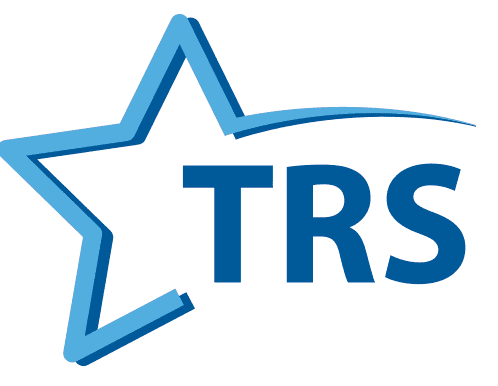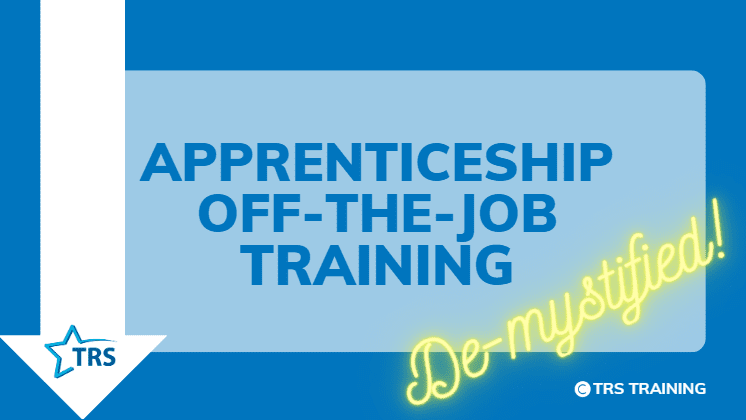Off-the-job training equating to at least 20% of working hours is a compulsory component of an apprenticeship. The apprenticeship will only qualify for government funding if this requirement is met. But what exactly constitutes off-the-job training? Both employers and apprentices sometimes need clarification about this, so we have produced a breakdown of what counts as off-the-job training on a TRS apprenticeship.
To calculate how much time should be spent on off-the-job training, working hours are capped at 30 hours per week, and this equates to an average of 6 hours of off-the-job training per week (i.e. 20% of 30 hours). An apprentice spends these 6 hours undertaking employer-led and TRS-led training. This diagram shows what forms the training can take.
Employer-led off-the-job training usually takes place in the workplace during working hours. You may be surprised how many activities are acceptable as forms of off-the-job training. The six hours weekly soon clock up before the apprentice and employer realise it! Here are some activities that count as off-the-job training:
Employer-led off-the-job training activities
Training courses
Any course the employer arranges for the apprentice to attend that isn’t part of their apprenticeship constitutes employer-led off-the-job training. So this might be a health and safety course, for example, any CPD course, or a bespoke company course.
Visiting other departments
Apprentices, like all staff, perform better when they understand how the entire organisation functions and how different departments are interrelated and contribute to organisational goals. Any time an apprentice spends visiting other departments to see what colleagues do counts as employer-led off-the-job training.
Shadowing colleagues
More experienced colleagues in and outside the apprentice’s department are a great source of knowledge. Investing time away from their job and watching a colleague carry out work-related tasks counts toward an apprentice’s off-the-job training.
Providing cover
Any occasion where an apprentice steps up and provides cover for a work colleague temporarily can be recorded as employer-led off-the-job training. This might be to stand in for someone who is off sick or on training themselves, or even a secondment opportunity. These instances will see an apprentice take on responsibilities outside their usual role and are opportunities for acquiring new knowledge, skills and behaviours.
Attending and chairing meetings
Attending and even chairing workplace meetings develops professional skills and behaviours in an apprentice. Examples of personal development include conducting oneself in meetings, listening effectively, taking notes and contributing to group discussions. Time spent attending meetings, therefore, counts towards off-the-job training.
Performance reviews
Of course, as with other employees, an apprentice will have regular performance reviews where their manager monitors and evaluates their performance against pre-determined indicators and objectives. These reviews count as off-the-job training.
1-2-1 meetings
Any one-to-one meetings that an apprentice has with their manager or another member of staff, where they are discussing performance, a specific project or other work-related matters, is a learning and development activity. Therefore, this too, constitutes employer-led, off-the-job training.
Attending conferences
Using time away from the job to attend a trade or business conference will benefit apprentices. Attending a conference is an excellent example of employer-led off-the-job training, from learning about new developments in the industry to socialising with professional peers.
TRS-led off-the-job activities
Online lessons/Virtual Learning Environment (VLE)
TRS tutors mainly teach the apprenticeship curriculum live via a virtual learning environment which apprentices access online. However, some training can take place face-to-face, depending on how the apprenticeship delivery has been set up with the company. In addition, to live learning sessions, apprentices can access videos and pre-recorded material. All this counts towards the off-the-job training hours.
E-portfolio work
As apprentices progress, they must document the evidence to demonstrate the development of their skills, knowledge and professional behaviours. The e-portfolio is an essential element of the apprentice journey and is vital in their final assessment. The TRS trainer oversees apprentices’ e-portfolio work, monitored in the regular review sessions with employers. Any time spent on e-portfolio development counts as off-the-job training.
Work-based reflection and reviews/meetings with the TRS trainer
Factored into an apprentice’s learning programme are structured sessions on work-based reflection guided by the TRS trainer. This is an opportunity to reflect on an apprentice’s practice to transform their experiences into learning, enhancing their performance. These sessions and all meetings with their TRS trainer count towards off-the-job training hours, as does work on monthly reports.
Time reviewing TRS research
TRS tutors provide apprentices with well-researched supplementary material for personal and workplace development. This includes safeguarding and wellbeing resources, career development, and IAG material. Time spent reviewing and implementing these resources is classed as off-the-job training.
Attending workshops
From time-to-time TRS will arrange workshops for apprentices to attend with peers and specialist professionals.
Recording off-the-job hours
To meet funding requirements, apprentices and their employers must ensure that any off-the-job activities are evidenced in the apprentice log. TRS tutors will monitor these regularly. We recommend that apprentices update their logs every week.
If TRS is already supporting you with apprenticeships and you have any questions about off-the-job training, please contact your TRS trainer. If you are not a client of TRS and want to learn more about how off-the-job training works, please contact us.




